Tule Tree Oaxaca: The Ultimate Guide [2024]
Disclosure: This post may contain affiliate links, meaning that I may get a small commission if you decide to make a purchase through my links, at no cost to you.
You’ve probably heard that there are lots of things to do and see in Oaxaca, but have you heard of the Tule Tree?
The Tule Tree, also known as El Árbol del Tule, El Tule or the Tree of Tule, is a positively enormous cypress tree just a few miles outside Oaxaca City in the state of Oaxaca, Mexico. It’s famous for having the world’s widest tree-trunk, and it is also Mexico’s oldest tree.
Although it’s well-known to local Oaxaqueños, it’s an attraction that isn’t always on the radar of travellers to Oaxaca. Everyone has heard about the ancient abandoned city of Monte Albán but few people know about the Tule Tree, even though the Tule Tree was alive at the time when Monte Albán was flourishing!
That’s a shame, because El Tule has stood for thousands of years and makes for a great family-friendly day-trip on your next trip to Oaxaca.
To make sure that you don’t miss out, I’ve set out below a comprehensive list of everything that you need to know about this beautiful natural wonder.
Let’s get right into it.
TULE TREE OAXACA: tHE ULTIMATE GUIDE
What is the Tule Tree?
Let’s start with what the Tule Tree actually is, which I think is particularly helpful if you’ve never heard of it before.
Brief Description of the Tule Tree
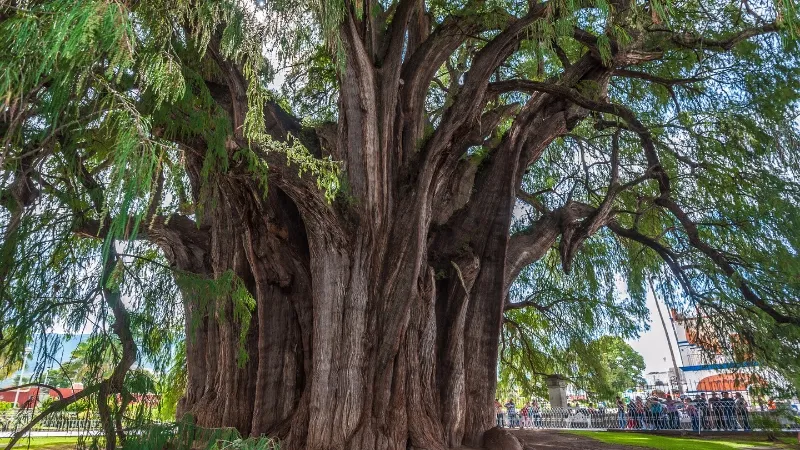
The Tule Tree is a colossal cypress tree located in a small town called Santa María del Tule in the state of Oaxaca, Mexico. It’s famous for being the world’s stoutest living tree. It’s so large that it takes more than 30 adults holding hands around its base to completely encircle it.
Photographs don’t really do justice to just how enormous El Tule really is. Although it is broader at its base than it is tall, it’s still a very tall tree at around 42 m high. The shadow it casts provides enough shade for over 500 people.
If that weren’t impressive enough, the Tule Tree is also ancient. Estimates put its age at over 2,000 years old, meaning that it was literally alive before Jesus Christ walked the Earth.
El Árbol del Tule Statistics
If you’re looking for all of the relevant statistics for the Tule Tree, I’ve set them out below (according to the stone placard beside the tree):
It’s worth pointing out that the data on the placard conflicts with well-known US ecologist Robert van Pelt’s measurements of the tree taken in 2005, on which the Guinness Book of Records figures are based. Van Pelt measured the tree as being 116 ft (35.4 m) tall and 118 ft (36.2 m) wide (with a canopy width of 141 ft (43.2 m).
I’ve set out in detail below where you’ll find Santa María del Tule and the Tule Tree and I’ve also included other fascinating information that most people don’t know about this wonder of nature.
Where is the Tule Tree Located?
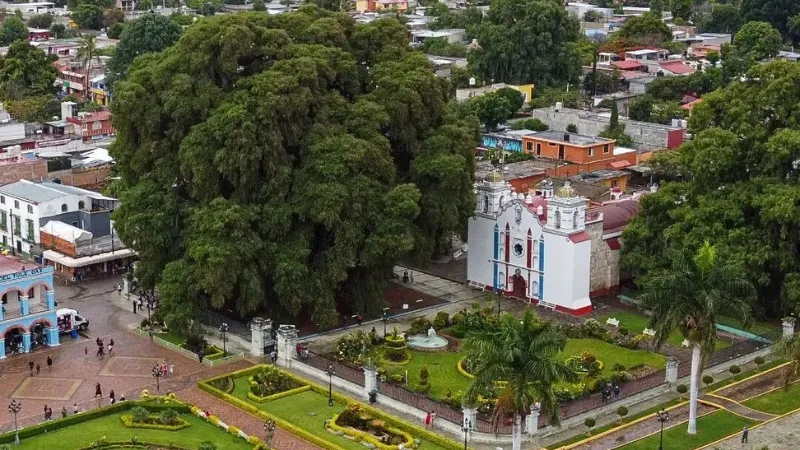
The Tule Tree is located in the town of Santa María del Tule, which is six miles to the west of Oaxaca City in the state of Oaxaca, Mexico.
It’s set within a low-fenced enclosure in a large plaza area next to a baroque church called the Templo de Santa María de la Asunción (Church of Saint Mary of the Assumption). If you want to get up close to the tree, you’ll need to pay 10 Mexican pesos to enter the fenced area. The payment is used for the upkeep of the tree and the nearby gardens.
On the other side of the tree is the palacio municipal (city hall), a beautiful example of 19th century Mexican architecture.
In addition to being known as the home of the Tule Tree, Santa María del Tule is also the home of two of the most popular types of Oaxacan mole, mole amarillo and mole verde (yellow mole and green mole). If you haven’t heard of mole, it’s a complex Mexican sauce somewhat similar to an Indian curry sauce, and yellow mole and green mole are two of the seven main types of mole in Oaxaca.
If you’re not familiar with Oaxaca, it is a region of southern Mexico, bound to the south by the Pacific Ocean. It neighbours the state of Chiapas to the east, the states of Puebla and Veracruz to the north, and the state of Guerrero to the west.
Oaxaca City is formally known as Oaxaca de Juárez and is the capital city and cultural center of Oaxaca state. It lies in the Oaxaca Valley surrounded by stunning mountains and beautiful landscapes. The town of Santa María del Tule is also in the Oaxaca Valley, a little further to the west of Oaxaca City.
The historic center of Oaxaca City is a UNESCO World Heritage Site and is adorned with beautiful cobblestoned streets, breathtaking colonial architecture, and colorful markets. It is known not only for the attractions within the city, but also for sites just outside of the city limits, including the Tule Tree.
Oaxaca is a rare gem, even within a country as beautiful as Mexico, and Tule Tree is definitely worth a visit in my opinion.
TULE TREE OAXACA: tHE ULTIMATE GUIDE
What Type of Tree is The Tule Tree?
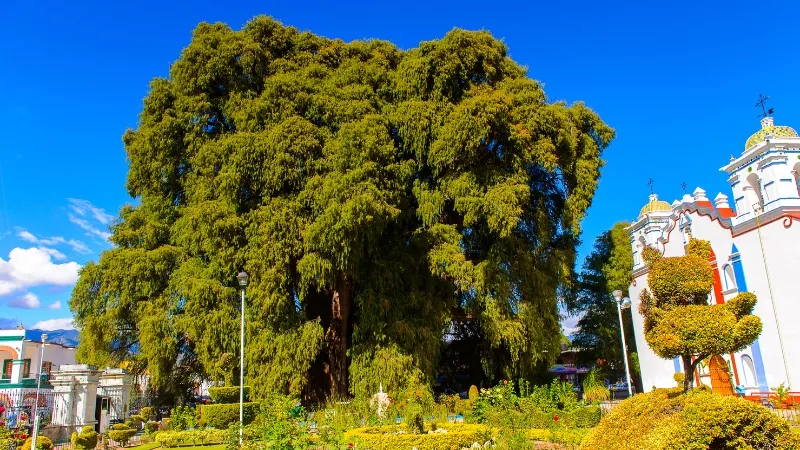
El Árbol del Tule is a Montezuma cypress tree and it is native to the United States, Mexico and Guatemala.
Montezuma cypress trees are also sometimes called river cypress trees because they often grow near rivers or other bodies of water like lakes. In Spanish, they’re known as an ahuehuetes or sabinos.
If you’re keen on your tree varieties, a Montezuma cypress tree is technically a conifer and is related to the pine tree. Like the pine tree, it’s evergreen with needle-like leaves, which help it reduce water loss.
Ordinarily, Montezuma cypress trees might reach 80 feet tall (24m) and about 35 feet wide (11m). El Árbol del Tule is already nearly twice as high and nearly four times as wide, so clearly it’s an over-achiever.
Is El Tule At Risk of Dying?
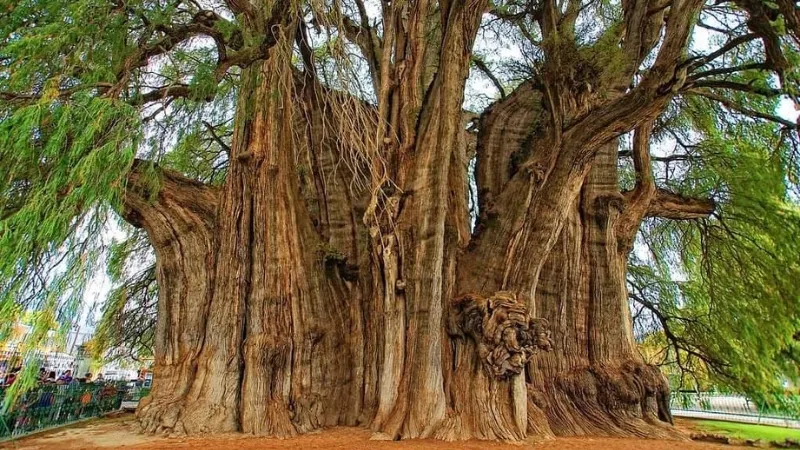
I mentioned above that Montezuma cypress trees thrive near water, and Santa María del Tule isn’t on a river or any other body of water. Santa María del Tule was once a wetland area, but it dried out over the last few hundred years.
This created a problem for the Tule Tree because it needs dozens of water per day to maintain its enormous structure. The tree previously had access to underground aquifers that quenched its thirst and allowed it continue to thrive, but over the years farming and increased local water use caused the levels of the acquifers to sink.
This started to take a toll on El Tule and after investigations were carried out in the 1990s, it was decided that something needed to be done. A team of forestry engineers were engaged by the town at significant cost to build an underground well so that the tree could continue to be supplied with the water it needs to survive.
As a result of the new well, El Árbol del Tule is currently believed to be in very good health with access to all of the water that it needs. There’s now no reason to think that it won’t live on for many years to come!
Is The Tule Tree Just One Tree?

For a long time, it was thought that the Tule Tree couldn’t possibly be a single tree because its trunk was just so colossal.
The prevailing theory at the time was that the Tule Tree was in fact several separate trees that shot up close together and whose root and trunk systems became entangled over time.
In the early nineties, DNA tests were carried out by biologists on the leaves of various different parts of the tree to put the theory of multiple trees to the test. However, to the surprise of many, the results concluded that the Tule Tree was in fact just the one genetic lifeform.
So if you arrive at El Tule and are gobsmacked by its size and you start having doubts, there have been tests carried out to confirm its provenance, so you are definitely looking at the real thing!
TULE TREE OAXACA: tHE ULTIMATE GUIDE
How Did The Tule Tree Get Its Name?
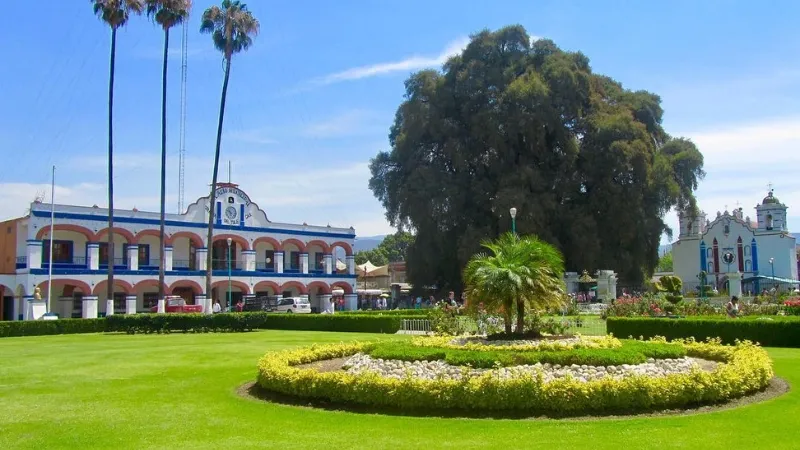
The word “tule” come from from the Nahuatl word tulle or tullin, which somewhat confusingly refers to a type of reed commonly known in English as bulrush or cattail. It’s that type of reed with the reddish-brown fluffy cotton-like bit at the top.
Hundreds of years ago, the area where Santa María del Tule now stands was marshland. Even back then, the Tule Tree was already a very large tree and its name most likely came from being located within that marshy area.
The Zapotec people called the Tule Tree ahuehuete or sabino, meaning “old tree of the water”, which also makes sense when you consider that the area was previously wetlands.
TULE TREE OAXACA: tHE ULTIMATE GUIDE
Cultural Significance Of the Tule Tree

The Tule Tree is more than just a large tree to local Oaxacans and to Mexicans more generally. It’s embedded very deeply in the local and more recently national culture.
There are a few different aspects to this, and I’ve explored each of them below in more detail.
The Legend of the Tule Tree
There are actually two legends about the beginnings of the Tule Tree.
According to the first legend, the Tule Tree was planted around 1,400 years ago by a man named Pechocha, who was a Zapotec priest of Ehécatl, the Zapotec god of the winds. According to the legend, the site was chosen because it was a sacred site.
Interestingly, this legend ties in with scientific estimates of El Tule’s age, which range from around 1,200 years to 3,000 years old.
The second legend surrounds Rey Condoy (King Condoy), a Herculean-like figure in Mixtec folklore who is believed to have begun the construction of nearby Mitla. He was said to have immense strength and to use a 130-lb branch of a Montezuma cypress tree as a walking stick.
The legend has it that Rey Condoy stopped to rest in the marshes of what is now Santa María del Tule and dug his walking into the earth. As soon as he did so, the stick laid down roots and sprouted new growth until it grew into the Tule Tree before his very eyes.
Spanish Spiritual Conquest
One of the things that the Spanish conquistadors did shortly after their arrival in Mexico in 1519 was to convert the local population to christianity.
In the Oaxaca valley, the Zapotec civilization had been established for over 2,000 years, so its religion was deeply ingrained on the local population when the Spanish arrived.
In order to drive a wedge between the people and their faith, the Dominican and Franciscan friars brought by the Spanish ordered the construction of churches on or near Zapotec sacred sites.
One such site was the Tule Tree, and for that reason the Templo de Santa María de la Asunción (Church of Saint Mary of the Assumption) was built next to the tree in the early 17th century.
Mexico’s National tree
In 1921, on the 100th anniversary of Mexico’s independence, the national tree of Mexico was named the Montezuma cypress.
The fact that the Tule Tree belonged to this genus of tree was no accident. In the proclamation, the Tule Tree was held out as a fitting example of Mexico’s deep and enduring history.
As the oldest living witness of Mexico’s changing landscape over the last two thousand years, I think it makes perfect sense that the Tule Tree has become directly associated with Mexico’s national identity.
Local Celebrations of the Tule Tree
On the second Monday in October of every year, the town of Santa María del Tule holds an annual festival in honor of its remarkable tree.
The festival features a street parade in traditional Oaxacan dress, lots of amazing food, and an offering of flower necklaces and sweets to guests and visitors.
Oaxacan festivals are always colorful and lots of fun, so if you’re in Oaxaca when the festival is being held, be sure to time your visit so that you can see it.
TULE TREE OAXACA: tHE ULTIMATE GUIDE
Are There Hidden Animals In The Tule Tree?
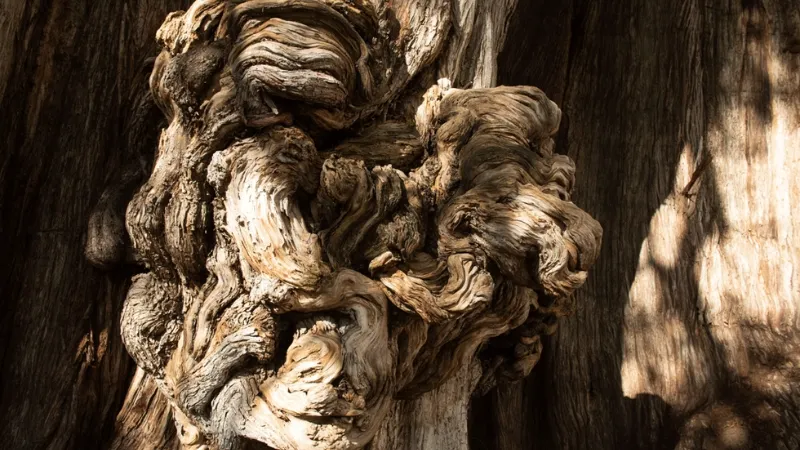
One of the cool things about the Tule Tree is that many of its gnarled outgrowths and criss-crossed branches look like petrified animals when you look at them from a particular direction. The Tule Tree is sometimes called “the tree of life” for this reason.
Local schoolchildren visit the tree and learn to point out all of the animals hidden in and amongst the tree. When you go to visit the tree, sometimes there will be groups of those children who will help you see the animals for a small tip.
If you look closely at the tree, you’ll be able to see an elephant and anteater, a stag, a lion’s head, and a crocodile, among other animals.
One of these is pictured in the image above. Can you see it?
TULE TREE OAXACA: tHE ULTIMATE GUIDE
Does El Tule Have a Family?
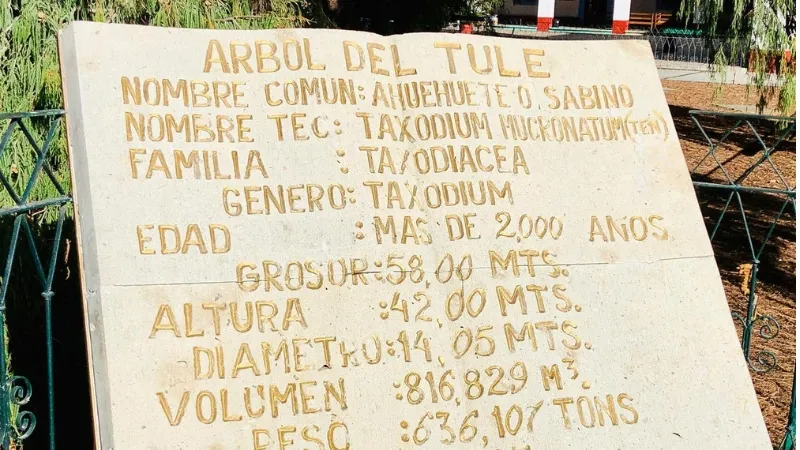
If you’re impressed by the Tule Tree, you might be surprised to know that it has an entire family nearby.
There are seven other members of the Tule Tree’s Montezuma cypress family living in Santa María del Tule. The Tule Tree is the father of the family and is thought to be the oldest member of the family.
One of these other family members is known as El Hijo del Tule (the son of Tule). Even though it is a huge tree, it doesn’t quite have the impressive size of its father and is “just” 1,000 years old.
The town of Santa María del Tule are understandably very proud of their Montezuma cypress family and they’re definitely a must see for any visit to Oaxaca.
Let’s look now at how you can practically visit the Tule Tree.
TULE TREE OAXACA: tHE ULTIMATE GUIDE
How Do I Get To the Tule Tree from Oaxaca City?

If you come to Oaxaca and plan to visit the Tule Tree, you’ll almost certainly base yourself in Oaxaca City. Oaxaca City is reasonably large, and has lots of available taxis, rental car branches, and a public bus network.
That means that you have a few different options when you’re planning how to travel the six miles from Oaxaca City to Santa María del Tule to visit El Árbol del Tule. You can take a taxi or a colectivo, rent a car and drive yourself, or take a public bus.
If you don’t mind a little exercise, another option is to rent a bicycle and cycle your way to the Tule Tree. You can also join one of the many tours that frequently visit El Tule.
I’ve set out more detail on each of these options below.
Drive

The simplest way to reach Santa María del Tule from Oaxaca City is to drive. It should take you around 30 minutes or so, depending on traffic.
Renting A Car
If you need to rent a car in Oaxaca, you can get one downtown or at the airport. In Oaxaca City, there are Alamo and Europcar branches on Calle Mariano Matamoros near Calle Porfirio Díaz and in the airport you can choose from Alamo, Europcar, Hertz, Enterprise Rent-A-Car and Car Rental Oaxaca.
I recommend using DiscoverCars to book the best deal available ahead of your arrival, and you can then pick it up from whichever branch is most convenient. You can expect to pay around US$30 per day plus gas for a basic rental car.
Best Routes
Santa María del Tule is west of Oaxaca City on highway 190, which passes just north of the historic center of Oaxaca. The simplest route is to drive north until you reach highway 190 and then head west.
Another option is to pick up highway 175 a few blocks west of the historic center and then head north-west until you come to highway 190 a few miles outside Oaxaca City. You can then join highway 190 and follow it the last few miles into Santa María del Tule.
Tip: Highway 190 splits in two just a mile or so outside Santa María del Tule. Make sure you stay on the north section because the new section to the south bypasses the Tule Tree.
Get a Taxi
If you don’t want to rent a car for the day but still want to travel by car, getting a taxi is a simple option.
Oaxaca City is full of taxis, so you’ll easily be able to hail one on the street. If you’d prefer to use an app, there’s no Uber in Oaxaca, but the DiDi app works, so you can use DiDi to call yourself a taxi as well.
A taxi will cost you around around 150 Mexican pesos (about US$7.50), and make sure you bring cash, because the driver won’t accept credit cards.
Take the Colectivo
A more economical way to travel is to take the colectivo (essentially a shared taxi) to Santa María del Tule. It’s also a great way to travel the way the local Oaxaqueños travel.
You can get a colectivo heading west on highway 190 (called Blvrd José Vasconcelos close to Oaxaca). You’ll need to look for one of the maroon shared taxis with “Tule” marked on it.
The colectivo should cost you about 15 Mexican Pesos to ride (US$1.00) and will take about 45 minutes.
Catch the Bus
The Oaxacan city buses don’t go all the way to Santa María del Tule but you can get a bus at the second class bus station. It’s about a mile to the west of the Zócalo, opposite the Central de Abastos de Oaxaca, one of Oaxaca’s fantastic markets.
The bus will cost you about 10 Mexican pesos (US$0.50) each way and will take around 45 minutes to an hour to arrive.
Bike

Another fantastic way to visit the Tule Tree is by bicycle.
Many hotels like Hotel Azul Oaxaca and Hotel Casona Oaxaca (pictured) can rent you a bicycle that you can use. If your hotel doesn’t rent bicycles, you can try Bicibella Oaxaca or Bike Flow Oaxaca, which are both in the historic center of Oaxaca.
If you think that cycling isn’t something you would ever consider doing in Oaxaca, it’s not as difficult as you might expect. There is a street in Oaxaca City called Avenida Ferrocarril where a disused railway line has been converted into a bicycle lane.
The only difficulty that you might have is getting over to the beginning of the cycle-lane. It starts right after highway 175 turns north, in Barrio La Noria, just to the west of the historic center. You’ll need to carefully navigate the roads or push the bicycle until you reach it.
Once you’re on the cycleway, the way to Santa María del Tule is quite flat, and you can follow it the entire way to Santa María del Tule.
Do a Tour
The last travel option to mention is taking a guided tour to visit the Tule Tree.
There are lots of different tours that you can take. You can do a guided cycling tour that basically follows the route described above, but can help you reach the cycleway and tell you a little about the Tule Tree when you arrive.
You can also combine the Tule Tree with other attractions like Hierve El Agua and Mitla and do one big day trip to see everything at once. Hierve El Agua and Mitla are also reached by travelling along highway 190, but they’re more than 25 miles further west from Santa María del Tule.
Personally, I think you’re better off taking your time and trying to see at most two attractions in a day, but if you’re pressed for time, a multi-attraction tour might be a good option for you.
I recommend using Viator to book a reputable tour. Viator has dozens of different tour options to the Tule Tree, including a guided cycle tour and a several multi-attraction tours.
TULE TREE OAXACA: tHE ULTIMATE GUIDE
What Else Is There To Do In Santa María del Tule?
There’s obviously no denying that the main attraction in Santa María del Tule is the Tule Tree, that’s clear.
However, there are a few other things that you should do while you’re in Santa María del Tule, because it is a little more than a town that just happens to have the world’s stoutest tree.
Take A Photo At The El Tule Sign

All around cities and towns in Mexico, you’ll find multicolored signs that are perfect for photographs. Locals will be more than happy to take a photograph for you if you ask politely.
The El Tule sign is in a great spot in the south-west corner of the manicured gardens. You can get a shot of yourself with the Tule Tree in the background flanked by both the Templo de Santa María de la Asunción and the city hall (palacio municipal).
Definitely a must for the scrapbook.
Visit the Templo de Santa María de la Asunción
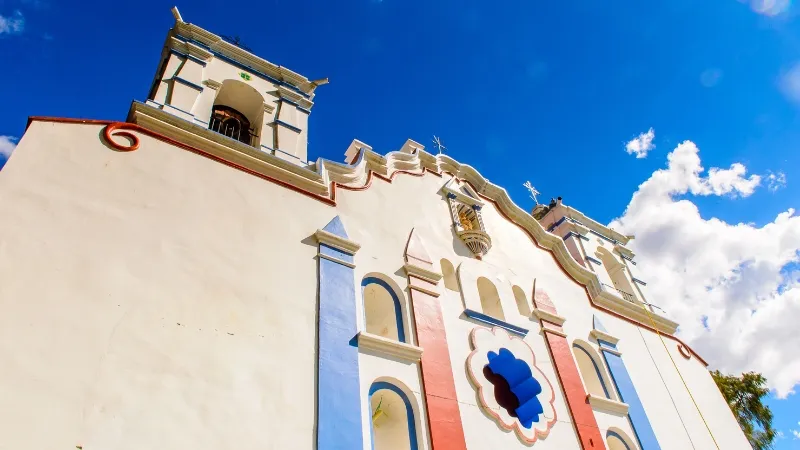
The Templo de Santa María de la Asunción is a small church with baroque architecture dating back to at least 1630, where it is mentioned by Bernabé de Cobo his book, the Spanish diary (Diario Español) .
Inside its simple wooden door, the church has an altar to the Lady Mary, who is the patron saint of town as well as of the church. Despite the relatively simply painted white walls, the altar is richly decorated with gold altar-pieces and gold-framed images of the Lady Mary.
Images of the crucifixion also adorn the walls and there are simple wooden pews for the faithful, although these are often moved to the sides of the nave to make room when it is busy.
There is a festival to the Lady Mary in mid-August each year with floral arches and other decorations and well as the multicolor ribbons typical of Oaxaca.
Shop For Local Food And Crafts

There are lots of local things to do right next to the Tule Tree, so be sure to spend a bit of time in the town before you head back to Oaxaca.
Just to the south of the Tule Tree, you have the artisanal market (Mercado de Artesanías) where you can buy all kinds of wonderful locally-produced products. Some vendors might even produce them right in front of you using looms for weaving and other traditional methods of fabrication. If you’re wondering where to look for a souvenir, this is the place to do it.
Next to the artisanal market, there is a great local food market (Mercado Gastronómico). You can get all kinds of great local food and bargain prices. You can try regional classics like tlayudas, empanadas, pan de yema and memelas, and if you’re feeling adventurous you can try a burned milk ice-cream (leche quemada).
If you’d prefer to sit down at a bar, there are some great mezcal bars nearby. Mezcalería El Sabor de Oaxaca is just to the west of the food market. Just to the north-east of the Tule Tree you also have Mezcal Burro and Mezcal Don Balta.
For restaurants, Restaurante El Milenario is to the south, and Casa Embajador de Oaxaca is a short walk to the north-west. Both serve highly-rated Mexican food.
TULE TREE OAXACA: tHE ULTIMATE GUIDE
Why Should You Visit Oaxaca?
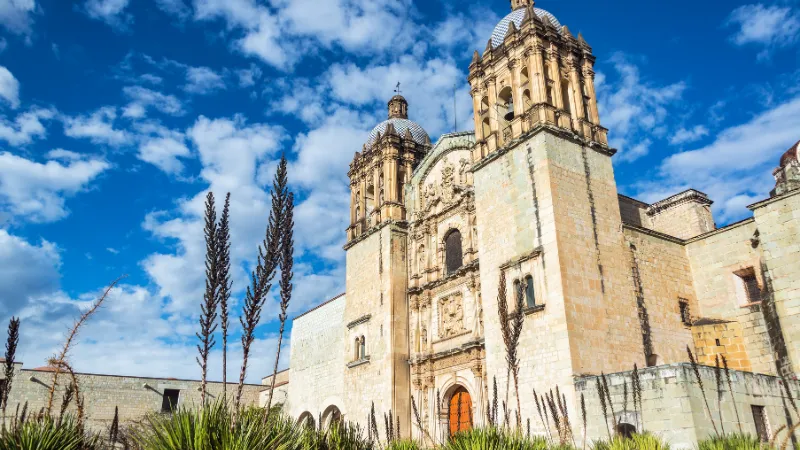
I hope that I’ve been able to convince you that you should visit Santa María del Tule in particular and Oaxaca more generally. Oaxaca is one of the most culturally rich areas of Mexico with beautiful colors everywhere and wonderfully friendly people and it’s somewhere that should definitely be on your must-see list in Mexico.
As amazing as the Tule Tree is, it’s actually just the tip of the iceberg when it comes to Oaxaca. Just 30 miles further east of the Tule Tree, you can visit Hierve el Agua, the fantastic fossilized waterfalls with cool mineral pools that you can soak in. There are also lots of archaeological sites near Oaxaca including Mitla and Monte Albán where you can see the ruins of fascinating Zapotec cities.
The city itself is also captivating. It has hundreds of beautiful colorful buildings that are centuries old and constructed in the Spanish colonial style. Each year it also holds countless flamboyant traditional festivals including Day of the Dead, La Guelaguetza, and Noche de Rábanos.
And once you’ve explored the city, you could also travel south to visit Oaxaca’s idyllic pacific coast and explore some of its little-known ocean paradises including Puerto Escondido and Huatulco.
All in all, I think that no trip to Mexico is complete without at least spending a few days in and around Oaxaca.
TULE TREE OAXACA: tHE ULTIMATE GUIDE
How Do I Get To Oaxaca?
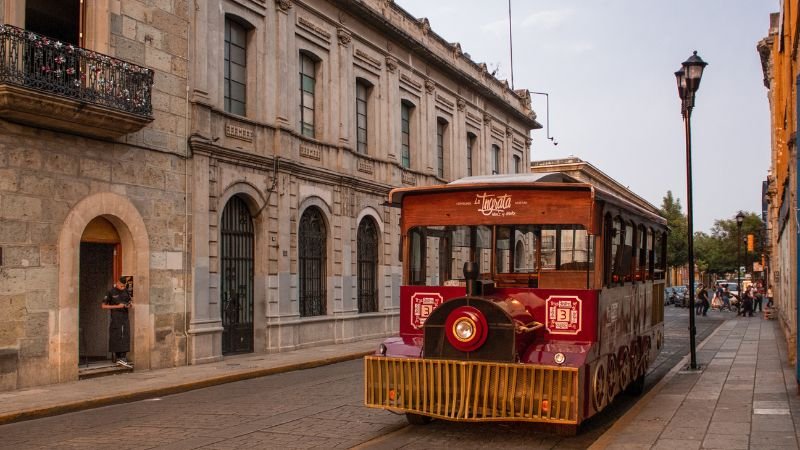
If I’ve persuaded you that you ought to be thinking about visiting Oaxaca, the next question that you probably have is how do you get there?
Well, while there are some direct flights to Oaxaca out of Dallas and Houston in Texas, the chances are good that you will fly into Mexico City on your way to Oaxaca. From there, you’ll need to decide how you want to get from Mexico City to Oaxaca.
You might fairly think that you’ll just change flights in Mexico City and fly the rest of the way to Oaxaca (and yes, Oaxaca does have an airport, called Xoxocotlán International Airport). If you’re pressed for time, that’s certainly the best option, and flight time is only one hour and twenty minutes.
However, you’ve actually got three options from which you can choose: plane, car, or bus. It’s too far to walk or cycle, there’s no train, and unless you want to go via Panamá, you can’t go by boat.
By plane, you can fly commercially or (if you can afford it) you can also fly privately. If you travel by car, you can drive yourself or hire a private driver. You can also take a tour for a day or two that is operated out of Mexico City.
In my view, the bus is great if you’re on a budget, and renting a car is perfect if you’re planning on doing a bit of a road trip through different parts of Mexico.
If you’re interested in finding out more, check out my article about the best way to get from Mexico City to Oaxaca.
TULE TREE OAXACA: tHE ULTIMATE GUIDE
Where Are The Best Places To Stay In Oaxaca?

When you make it to Oaxaca, the next obvious question will be where do you stay? Well, you’re in luck because Oaxaca has an amazing array of places to stay for you to choose from. Whatever your heart desires, you’ll find it in Oaxaca.
If you’re looking for a luxury hotel, I would start by looking at Quinta Real, Casa Santo Origen or the Grand Fiesta Americana.
If a boutique hotel is more your thing, then check out NaNa Vida Hotel Boutique, Casa Antonieta Oaxaca or Hotel Parador de Alcalá Oaxaca.
If you want to look at longer lists of curated options, take a look at any of the ones below that take your fancy:
- Best Hotels In Oaxaca
- Best Luxury Hotels In Oaxaca
- Best Boutique Hotels in Oaxaca
- Best Haciendas in Oaxaca
- Best Hostels in Oaxaca
You can also check prices and availability at Booking.com or Expedia.com.
TULE TREE OAXACA: tHE ULTIMATE GUIDE
When is the Best Time to Visit Oaxaca?

Oaxaca has a subtropical high-altitude climate, meaning that it typically has warms day and then cools off in the evenings.
There is also a dry season and a rainy season, with the rainy season lasting from June through to September.
The best time to visit Oaxaca therefore depends a little or your personal preference, but in my opinion, late October is the best time to visit Oaxaca. In addition to being able to visit El Tule, the days are warm, the nights are cool, and the city is lively. You’ll also be able to see the Día de los Muertos festival, which is arguably better in Oaxaca that anywhere else in Mexico.
The downside, though, is that prices are expensive and the city is full of tourists doing exactly the same thing as you!
If you’re interested in finding out more about your options here, check my related article on the best time to visit Oaxaca.
TULE TREE OAXACA: tHE ULTIMATE GUIDE
What Should I Pack To Go To Oaxaca?

Oaxaca has warm days all year, with cool nights that become cold in the winter months of December through to February.
The temperature fluctuates during the day from around 49°F (10°C) to 85°F (30°C). Local Oaxacans deal with this by wearing layers.
You put your sweater or jacket on in the morning and then take it off a few hours later when the sun has warmed everything up.
If you travel during the rainy season from June to September, you can also expect to have very humid days. After a heavy rain, it isn’t uncommon for the humidity to reach over 80%.
So, what should you pack? Whenever you travel, you should bring (or buy shortly after you arrive) a comfortable pair of walking shoes, a sun-hat, lot of light clothes for the day, and a light jacket or cardigan for the evenings.
If you travel in the winter months, you probably want to add a scarf to that list and opt for the slightly warmer jacket.
If you’re going to travel in the rainy season (which can be a great way to spare your wallet!) you should include a few extra articles of clothing (because you can expect to get a bit sweaty) and a fold-up umbrella.
TULE TREE OAXACA: tHE ULTIMATE GUIDE
Where Are The Best Oaxaca Beaches?

If you decide to visit Oaxaca’s pacific coast after you’ve seen El Tule and all of the attractions in and around Oaxaca City, you’ve made a good call because Oaxaca has no shortage of amazing beaches.
Playa Mazunte and Playa Zipolite are laid-back beaches and Playa Zipolite even has a clothing optional area if that is your thing!
Playa La Entrega in Huatulco is known for its clear waters and coral reefs, making it a great spot for snorkeling and swimming.
If you’re looking for a place to surf, Playa Zicatela in Puerto Escondido is known for big sets, but if you’re looking for something in Puerto Escondido that is more relaxed, you can visit the sheltered cove of Playa Carrizalillo.
If you’re wondering what airport is closest to Oaxaca for flights to Puerto Escondido or Huatulco, it is still Xoxocotlán International Airport. Daily direct flights are available.
Check out my related article on Oaxaca’s best beaches if you’re interested in finding out more.
TULE TREE OAXACA: tHE ULTIMATE GUIDE
Final Thoughts
If you’ve made it this far, thank you for reading and I hope I’ve been able to help you with information about the Tule Tree.
I really do think it’s a great attraction and it’s one that you can get something out of whether you’re travelling alone, as a couple, with your friends or with your family. Natural beauty is always heartwarming, because you get to appreciate the wonderful things that our planet is capable of producing.
If you’d never heard of the Tule Tree or Oaxaca before reading this and neither of them was really on your radar, I would strongly recommend reading a little more about Oaxaca before you lock up your itinerary. I really do think that a trip to Oaxaca is a must on any trip to Mexico, even if just for a few days.

![Is Oaxaca Worth Visiting: The Ultimate Guide [2024]](https://capricioustravel.com/wp-content/uploads/2023/08/Is-Oaxaca-Worth-Visiting-Monte-Alban-1-800x419.webp)
![Oaxaca to Guadalajara: 6 Best Ways to Travel [2024]](https://capricioustravel.com/wp-content/uploads/2024/02/Oaxaca-to-Guadalajara-Oaxaca-Templo-de-Santo-Domingo-de-Guzman-and-Guadalajara-Cathedral.webp)
![Morelia to Cancún: 5 Best Ways to Travel [2024]](https://capricioustravel.com/wp-content/uploads/2024/02/Morelia-to-Cancun-the-Morelia-Cathedral-and-the-Cancun-hotel-zone.webp)
![Huatulco To Oaxaca: 7 Best Ways To Travel [2024]](https://capricioustravel.com/wp-content/uploads/2023/09/How-To-Get-From-Huatulco-to-Oaxaca-800x450.webp)
![Oaxaca to Zipolite: 7 Best Ways to Travel [2024]](https://capricioustravel.com/wp-content/uploads/2023/09/How-To-Get-From-Oaxaca-To-Zipolite-800x450.webp)
![Posada Real Puerto Escondido: The Definitive Review [2024]](https://capricioustravel.com/wp-content/uploads/2023/11/Posada-Real-Puerto-Escondido-Cocos-Pool-Area-800x450.webp)